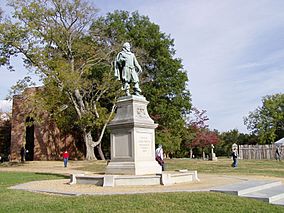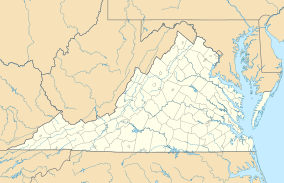Historic Jamestown facts for kids
Quick facts for kids Jamestown National Historic Site |
|
|---|---|

A statue of John Smith commemorating the site of the first permanent English settlement in America.
|
|
| Location | James City County, Virginia, United States |
| Nearest city | Jamestown, Virginia |
| Area | 20.63 acres (8.35 ha) |
| Established | May 13, 1607 |
| Governing body | Preservation Virginia (in partnership with NPS) |
| Website | Historic Jamestowne |
|
Jamestown National Historic Site
|
|
| Location | Jamestown Island, Jamestown, Virginia |
| Area | 20.6 acres (8.3 ha) |
| Built | 1607 |
| NRHP reference No. | 66000840 |
| Significant dates | |
| Added to NRHP | October 15, 1966 |
Historic Jamestown is a very important place in American history. It's where the first permanent English settlement in North America was built in 1607. This settlement was called James Fort, and later it grew into the town of Jamestown.
The site is on Jamestown Island, right on the James River in Jamestown, Virginia. Today, it is managed by two groups working together: Preservation Virginia and the U.S. National Park Service. It is part of Colonial National Historical Park.
Jamestown was officially named a National Historic Site on December 18, 1940. It was also added to the National Register of Historic Places on October 15, 1966. In 2007, it was even recognized as a National Historic Chemical Landmark. Close by, you can also visit Jamestown Settlement, which is a living history museum. It shows what life was like in the early colony.
Contents
History of Jamestown
Jamestown was founded on May 13, 1607. It was the very first permanent English settlement in North America. When the first 100 or so colonists arrived, they immediately started building a fort. This fort was meant to protect them from local Virginia Indian tribes and possible attacks from the Spanish.
Between 1609 and 1610, the colony faced a very difficult time. This period is known as the "starving time." There wasn't enough food, and new supplies from England were delayed. Many colonists also got sick. Only about 60 colonists survived this terrible period.
New colonists and supplies eventually arrived, helping the settlement grow. Over the next few decades, Jamestown became the main center of government for the English colonists. Many ships arrived from England, bringing more people to the new land. At its busiest, about 500 people lived in or around Jamestown. In 1619, the first Africans arrived in the colony. One of them was a woman named Angela.
Jamestown was the capital of the Virginia Colony for many years. In 1676, during a conflict called Bacon's Rebellion, much of Jamestown was burned down. However, the town was rebuilt. Then, in 1698, it accidentally burned down again. After this second fire, the capital was moved to a higher area called Middle Plantation in 1699. This new capital was later renamed Williamsburg. Once the capital moved, Jamestown quickly became a much smaller settlement. By the 1750s, the land was mostly used for farming.
Because of its location on the James River, Jamestown Island saw some action during the American Revolutionary War (1776-1781). The area was used as a military post. American and British prisoners of war were sometimes exchanged here.
In the 1800s, Jamestown Island was mostly quiet farmland. During the American Civil War in 1862, a Confederate fort was built there. It was called Doller's Point Battery. This fort was meant to protect Richmond from Union warships. Union forces also had a battery across the river. The Ambler Farm on the island was burned by escaped slaves who found safety there. After the war, the area returned to farmland until efforts to preserve its history began in the late 1800s.
Preserving Jamestown's History
In the late 1800s, people became very interested in Jamestown's history again. By 1893, a couple named Mr. and Mrs. Edward Barney owned the site. They generously donated 22.5 acres of land on Jamestown Island to Preservation Virginia. This land included the old 17th-century tower of the Jamestown Church.
At this time, the river was eroding the island's western shore. Many people thought that the original James Fort was completely underwater. To stop the erosion, a sea wall was built in 1900 with help from the government. In 1907, for the 300th anniversary of the settlement, the current Jamestown Church was rebuilt. It used the original 17th-century tower that had survived.
In 1932, a man named George C. Gregory found the foundation of the first capitol building from around 1646. In 1934, Colonial National Historical Park took over the rest of the island. They partnered with Preservation Virginia to protect the area and teach visitors about its history. The site was officially named Jamestown National Historic Site in 1940. It was added to the National Register of Historic Places in 1966. The National Park Service now takes care of the rest of the island. They have even recreated the foundations of buildings from the post-1610 Jamestown town.
In 1994, as the 400th anniversary approached, Preservation Virginia decided to fund a 10-year archaeological project. This project was called Jamestown Rediscovery. Its goal was to find any remains of James Fort. By 1996, they had found James Fort! It turned out that only a small part of its western side had been lost to river erosion.
Many preparations were made for the Jamestown 2007 event, which celebrated the 400th anniversary. Important people like President George W. Bush and Dick Cheney visited the site. Queen Elizabeth II also visited on May 4, 2007, to mark the anniversary. She had visited the park once before in 1957. As Queen Elizabeth noted, Jamestown was the beginning not just for America, but for the British Empire.
Important Structures and Monuments
The Historic Jamestowne area on Jamestown Island has many important buildings and monuments. Some are historical ruins, and others are modern additions.
Old Town Area
This part of the site includes the ruins of the original 1607 James Fort. You can also see the restored Jamestown Church and the remains of the old Statehouse building here.
New Town Area
Located to the east of the Old Town, this area has the ruins of the Ambler Mansion. It also includes the remains of a rowhouse and the Governor Harvey House.
Monuments and Statues
There are several monuments and statues around Historic Jamestown, each telling a part of its story.
Tercentenary Monument
The tall Tercentenary Monument looks a bit like the Washington Monument. It was placed on Jamestown Island by the U.S. government in 1907 for the 300th anniversary. It is 103 feet tall and made of granite. The front of the monument says: "Jamestown - The first permanent colony of the English people. The birthplace of Virginia and of the United States - May 13, 1607."
General Assembly Monument
The General Assembly Monument was unveiled on July 31, 1907. It was a gift from the Norfolk branch of the APVA. This small stone pillar is near the church. It remembers the first meeting of Virginia's General Assembly in July 1619.
John Smith Statue
The bronze John Smith statue was unveiled on May 13, 1909. It was a gift from Joseph and Isobel Bryan, who were early supporters of the APVA. The statue is 20 feet tall, including its granite base. The base says: "John Smith, Governor of Virginia, 1608." It also shows Smith's personal motto, vincere est vivere, which means "to live is to conquer."
Pocahontas Statue
The bronze Pocahontas statue was first unveiled in June 1922. It used to stand where it could "welcome" visitors arriving by ferry. In 1957, it was moved closer to the APVA entrance gate. In 2014, it was moved slightly again for archaeological work.
Hunt Shrine
Also in June 1922, The Colonial Dames of America put up the Hunt Shrine. It is dedicated to Robert Hunt, who was the first Anglican minister of the colony. The shrine has a carving that shows the 1607 church service. Its inscription, from John Smith, talks about how important Hunt was to the colonists.
Wooden Cross
A wooden cross stands near the entrance to the Archaearium museum. The APVA put it there in 1957. It honors the settlers who died in the first difficult years of the colony. The inscription remembers them as "the founders of this nation."
Voorhees Archaearium Museum
The Nathalie P. and Alan M. Voorhees Archaearium is a museum at Historic Jamestown. It displays many artifacts that have been dug up from the site. The building itself is built over the excavated remains of the last Statehouse in Jamestown, which visitors can see. The museum opened just before the 400th anniversary of the settlement. It shows objects that belonged to the colonists 400 years ago.
Gallery
-
Pocahontas statue, July 2007














